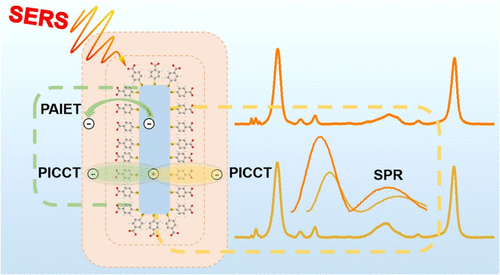当前位置:
X-MOL 学术
›
ACS Appl. Nano Mater.
›
论文详情
Our official English website, www.x-mol.net, welcomes your
feedback! (Note: you will need to create a separate account there.)
Charge Transfer in 4-Mercaptobenzoic Acid-Stabilized Au Nanorod@Cu2O Nanostructures: Implications for Photocatalysis and Photoelectric Devices
ACS Applied Nano Materials ( IF 5.3 ) Pub Date : 2021-01-05 , DOI: 10.1021/acsanm.0c02729 Lin Guo 1 , Zhu Mao 2 , Chao Ma 1 , Jiawei Wu 1 , Lin Zhu 1 , Bing Zhao 1 , Young Mee Jung 3
ACS Applied Nano Materials ( IF 5.3 ) Pub Date : 2021-01-05 , DOI: 10.1021/acsanm.0c02729 Lin Guo 1 , Zhu Mao 2 , Chao Ma 1 , Jiawei Wu 1 , Lin Zhu 1 , Bing Zhao 1 , Young Mee Jung 3
Affiliation

|
Nanoscale materials have an irreplaceable advantage in solar energy utilization because of their perfect match with visible light wavelength on the length scale. Charge transfer (CT) between a metal nanoparticle and contacted nanoscale semiconductor plays a significant role in photoinduced energy transfer. Here, we fabricated a new complex, a gold nanorod-4-mercaptobenzoic acid@Cu2O (Au NR-MBA@Cu2O) core–shell nanostructure, and used surface-enhanced Raman scattering (SERS) spectroscopy of the interlayer MBA molecules to investigate the CT process occurring between the Au NRs and Cu2O. In our system, different surface plasmon absorption bands were adjusted by tuning the thicknesses of the Cu2O shells on the Au NR core to explore the influence of plasmon absorption at different incident Raman laser lines. By analyzing the SERS spectra, the degree of CT was calculated, and the consequences can be fully explained by photoexcitation across interface electron transfer and plasmon-induced interfacial charge transfer transition at laser excitation wavelengths of 633 and 785 nm. This experiment introduced a simple, effective, and intuitive approach to observe the CT process in metal semiconductors by SERS. The results of our study will improve in photocatalytic efficiency and photoelectric devices.
中文翻译:

4-巯基苯甲酸稳定的Au Nanorod @ Cu 2 O纳米结构中的电荷转移:对光催化和光电器件的影响。
纳米级材料在长度利用方面与可见光波长完美匹配,因此在太阳能利用方面具有不可替代的优势。金属纳米粒子与接触的纳米级半导体之间的电荷转移(CT)在光诱导的能量转移中起着重要作用。在这里,我们制造了一个新的复合物,即金纳米棒-4-巯基苯甲酸@Cu 2 O(Au NR-MBA @ Cu 2 O)核-壳纳米结构,并使用了夹层MBA的表面增强拉曼散射(SERS)光谱分子以研究发生在Au NRs和Cu 2 O之间的CT过程。在我们的系统中,通过调节Cu 2的厚度来调节不同的表面等离子体激元吸收带用金壳NR核上的O壳来研究不同入射拉曼激光线对等离子体吸收的影响。通过分析SERS光谱,可以计算出CT的程度,其结果可以通过在633和785 nm的激光激发波长处的界面电子转移和等离激元诱导的界面电荷转移跃迁进行光激发来完全解释。该实验引入了一种简单,有效且直观的方法,以观察SERS在金属半导体中的CT过程。我们的研究结果将提高光催化效率和光电器件。
更新日期:2021-01-22
中文翻译:

4-巯基苯甲酸稳定的Au Nanorod @ Cu 2 O纳米结构中的电荷转移:对光催化和光电器件的影响。
纳米级材料在长度利用方面与可见光波长完美匹配,因此在太阳能利用方面具有不可替代的优势。金属纳米粒子与接触的纳米级半导体之间的电荷转移(CT)在光诱导的能量转移中起着重要作用。在这里,我们制造了一个新的复合物,即金纳米棒-4-巯基苯甲酸@Cu 2 O(Au NR-MBA @ Cu 2 O)核-壳纳米结构,并使用了夹层MBA的表面增强拉曼散射(SERS)光谱分子以研究发生在Au NRs和Cu 2 O之间的CT过程。在我们的系统中,通过调节Cu 2的厚度来调节不同的表面等离子体激元吸收带用金壳NR核上的O壳来研究不同入射拉曼激光线对等离子体吸收的影响。通过分析SERS光谱,可以计算出CT的程度,其结果可以通过在633和785 nm的激光激发波长处的界面电子转移和等离激元诱导的界面电荷转移跃迁进行光激发来完全解释。该实验引入了一种简单,有效且直观的方法,以观察SERS在金属半导体中的CT过程。我们的研究结果将提高光催化效率和光电器件。






























 京公网安备 11010802027423号
京公网安备 11010802027423号